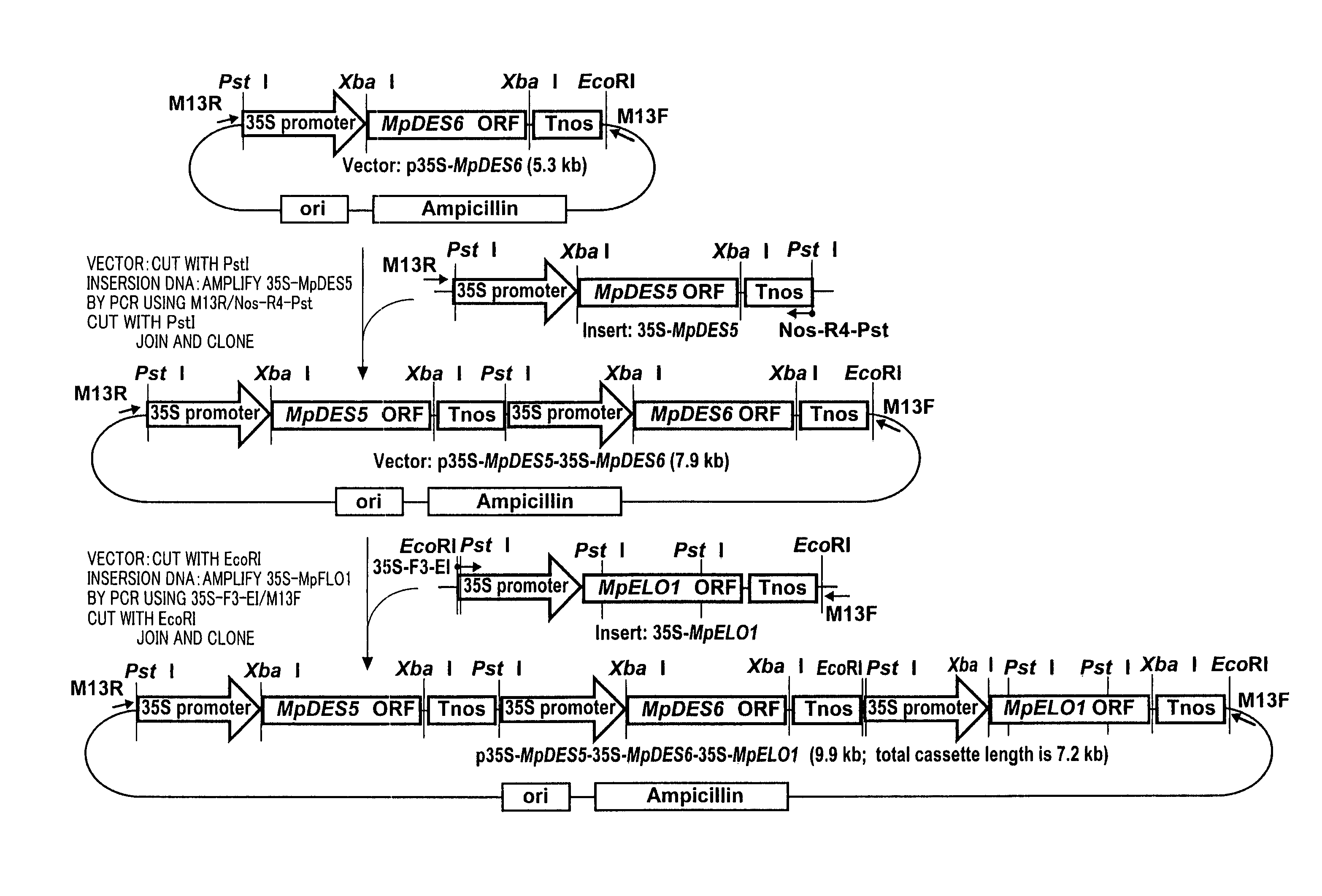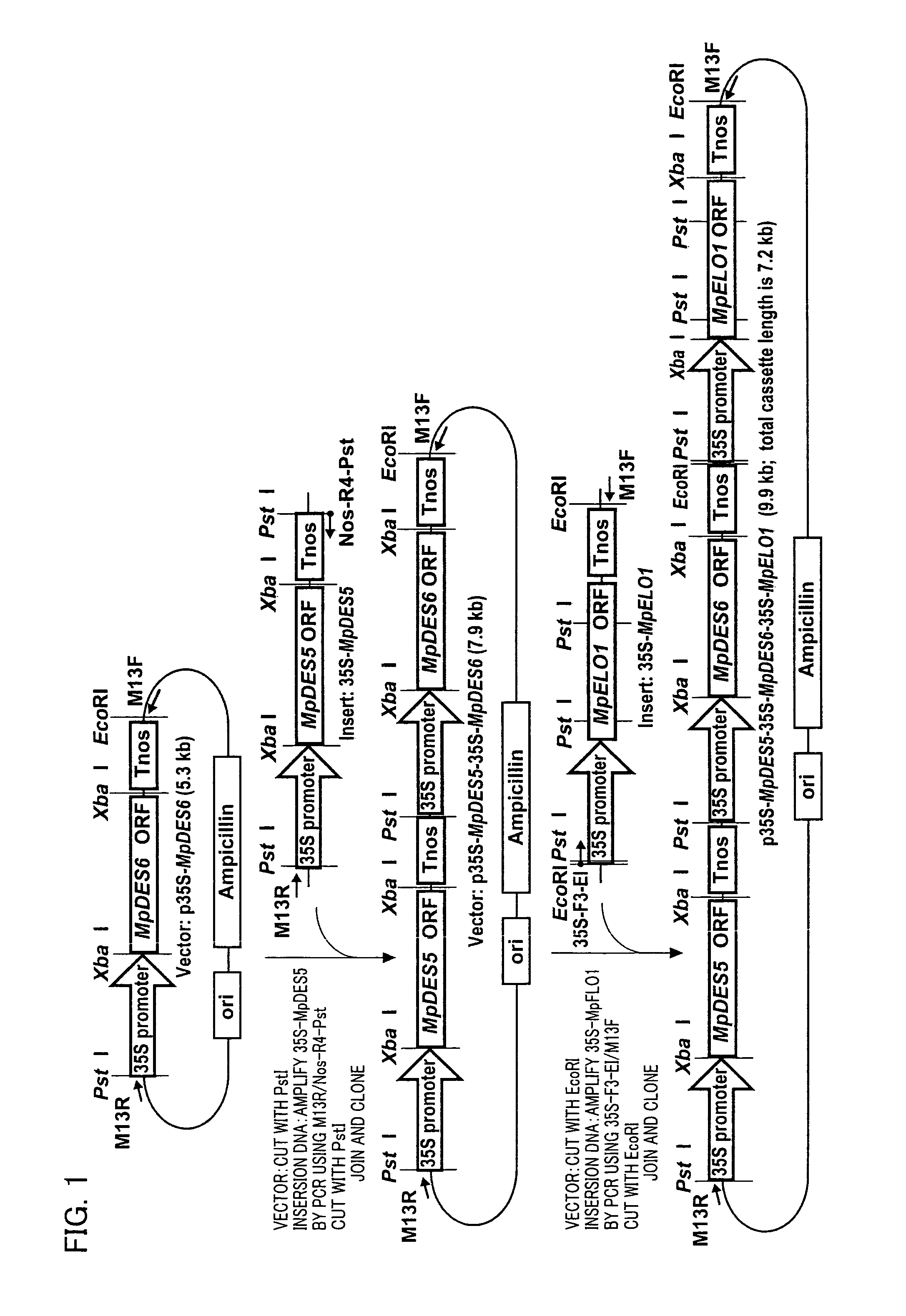Marchantiales-Derived Unsaturated Fatty Acid Synthetase Genes And Use Of The Same
- Summary
- Abstract
- Description
- Claims
- Application Information
AI Technical Summary
Benefits of technology
Problems solved by technology
Method used
Image
Examples
example 1
Isolation of Marchantia polymorpha-Derived Δ6 Desaturase Gene
[0162]A comparison of amino acid sequences of cloned Δ6 desaturases has confirmed that the amino acid sequences Trp-Trp-Lys-(Glu / Asp)-Lys-His-Asn (SEQ ID NO: 37) and Trp-Phe-Thr-Gly-Gly-Leu-Asn (SEQ ID NO: 38) were conserved. To isolate a Marchantia polymorpha-derived Δ6 desaturase gene, the following degenerate primers encoding the above amino acid sequences were used:
dΔ6DES-F:(SEQ ID NO: 7)5′-TGGTGGAA(A / G)GA(A / G / T / C)AA(A / G)CA(T / C)AA-3′;anddΔ6DES-R:(SEQ ID NO: 8)5′-(A / G)TTIA(A / G)ICCICCIGT(A / G)AACCA-3′.
[0163](“I” denotes inosine, and more than one nucleotide exist in parentheses.)
[0164]A thallus of E-line Marchantia polymorpha (see Transgenic Res. 9, p 179, 2000) was used as a sample. Isolation of poly(A)+ RNA from the thallus was carried out in accordance with the method described in Biosci. Biotechnol. Biochem. 67, p 605, 2003; Biosci. Biotechnol. Biochem. 67, p 1667, 2003. 1.5 μl of isolated poly(A)+ RNA was reverse-tra...
example 2
Isolation of Marchantia polymorpha-Derived Δ6 Chain Elongase Gene
[0170]A comparison of amino acid sequences of cloned Δ6 chain elongases has confirmed that the amino acid sequences Val-Glu-Phe-Met-Asp-Thr-Val (SEQ ID NO: 39) and Lys-Tyr-Leu-Phe-Trp-Gly-Arg (SEQ ID NO: 40) were conserved. To isolate a Marchantia polymorpha-derived Δ6 chain elongase gene, the following degenerate primers coding for the above amino acid sequences were used:
dΔ6ELO-F:(SEQ ID NO: 11)5′-GTIGA(A / G)TT(T / C)ATGGA(T / C)ACIGT-3′;anddΔ6ELO-R:(SEQ ID NO: 12)5′-C(G / T)ICCCCA(A / G)AAIA(A / G)(A / G)TA(T / C)TT-3′.
[0171]PCR was carried out using the these primers (dΔ6ELO-F and dA6ELO-R), and the resulting DNA fragments were subcloned. Nucleotide sequences of the clones were determined, and a full-length cDNA was obtained for clones that had a target cDNA sequence, using the following primers:
MpELO1-02R:5′-GCGAGCTTTCTCGTTCTTTCCC-3′;(SEQ ID NO: 13)andMpELO1-O1F:5′-TATGATTTTGAAGCGCAACACG-3′.(SEQ ID NO: 14)
Note that, the material...
example 3
Isolation of Marchantia polymorpha-Derived Δ5 Desaturase Gene
[0174]The Δ5 desaturases of other species have a cytochrome b5 domain at their N-terminus. From this, it was speculated that a Marchantia polymorpha-derived Δ5 desaturase gene belongs to a cytochrome b5-domain fusion desaturase gene family, as does the Δ6 desaturase gene. However, in Phaeodactylum tricornutum and fungi, the homology between the Δ5 desaturase and Δ6 desaturase is very poor at an amino acid level. As such, amino acid sequences of the Δ5 desaturase and Δ6 desaturase were compared in a filamentous fungus (M. alpina). The comparison found local presence a contiguous conserved sequence of 4 to 5 residues, which is at least required for the designing of degenerate primers. Surprisingly, the amino acid sequences were more conserved between the Δ5 desaturase and Δ6 desaturase of the same species than between Δ5 desaturases obtained from different species. This suggests the presence of a species-specific conserved s...
PUM
| Property | Measurement | Unit |
|---|---|---|
| Composition | aaaaa | aaaaa |
| Acidity | aaaaa | aaaaa |
| Chemical shift | aaaaa | aaaaa |
Abstract
Description
Claims
Application Information
 Login to View More
Login to View More - R&D
- Intellectual Property
- Life Sciences
- Materials
- Tech Scout
- Unparalleled Data Quality
- Higher Quality Content
- 60% Fewer Hallucinations
Browse by: Latest US Patents, China's latest patents, Technical Efficacy Thesaurus, Application Domain, Technology Topic, Popular Technical Reports.
© 2025 PatSnap. All rights reserved.Legal|Privacy policy|Modern Slavery Act Transparency Statement|Sitemap|About US| Contact US: help@patsnap.com


